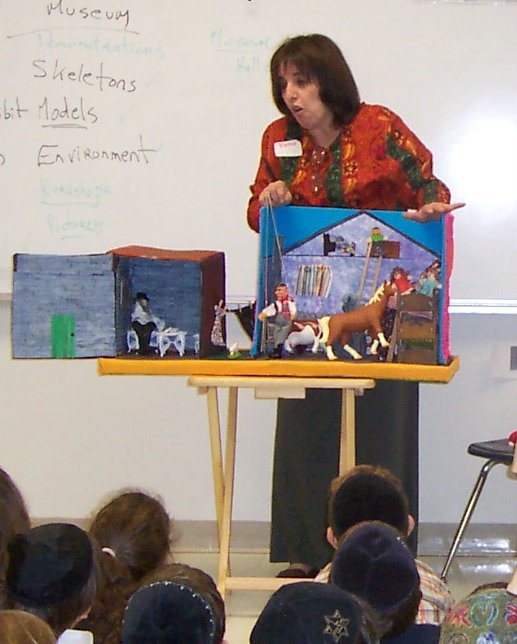
JEWISH HERITAGE
THROUGH FOLKTALES AND OTHER STORIES
Yeshivah of Flatbush
2006-2007
(The faces of the children are not displayed because I do not have parental permission slips. In any case, it might be best not to display clear,identifiable images of children on the internet for security reasons.)
Despite the fact that the Jewish population throughout the world is small, this religious/ethnic minority shares a rich cultural heritage. In this project the children explored one aspect of this heritage--folktales and other stories based on Jewish traditional life.
Project 1:
The first grade children began our study of Jewish cultural heritage with a very well-known folktale from the Jewish communities of Eastern Europe. A "retelling" of the story for the children in partial rhyme was presented in a puppet show. The title of this version is: THE RABBI HELPS OUT.
This story tells of a man who lives in a small house with his mother, his wife, and his six children. It is very noisy in his home. Finally, he can not stand it anymore. He seeks advice from the Rabbi. The Rabbi tells the man to take his animals into his house,which mde things worse. Finally, the Rabbi told the man to take the animals out of the house. The man discovered that things weren't so bad at the start . This story is published under the title : IT COULD ALWAYS BE WORSE, retold by Margot Zemach.

The children constructed models of the man's house out of movie theater snack boxes.They cut out drawings, pasted them on the back of the model, or on sticks and placed them in the house. A styrofoam base had been pasted on the bottom of both sections of the box.


,,,,,,,,,, ................
................
*
PROJECT 2:
The story first presented as a puppet play was transformed into a Beginner Story. The children were introduced to some of the words used in the story by using magnetic word cards. The children made sentences.
The children read the story and did some written exercises in the story booklet.
*
Project 3:
Children seem to love the Chanukah (Hanukah) story: HERSHEL AND THE HANUKAH GOBLINS. Hershel had to save Hanukah for the townspeople by confronting the Goblins.
After hearing the story, the children made Chanukah Menorah's using sticks positioned in styrofoam. They drew pictures of the Chanukah Goblins and pasted one on each candle.
A special Chanukah Menorah was made for the Boro Park Chapter of Hadassah, and presented to the women during an honorary meeting.
*
Project 4:
Simms Taback, a Caldecott winning artist/writer, wrote and
illustrated KIBITZERS AND FOOLS, a collection of amusing Jewish folktales.
For this project, the children heard the first story, called THE SIGN.
They learned that a Kibitzer is a person who gets involved in other people's business, usually giving unwanted advice.In the story THE SIGN, Motke puts a sign over the door to his fish store. One by one, kibitzers come by and tell him to take words out of the sign for one reason or other. Motke ends up with no sign at all, and his business begins to do poorly. Finally, a kibutzer comes by and suggests that Motke put up a sign to help attract customers.
The children worked with words pasted on magnets to form sentences.
The children then worked in booklets in which the story was rewritten in rhyme. They had to make judgments , write in appropriate words, paste signs, and draw pictures.
*
Project 5:
The story, JOSEPH HAD A LITTLE OVERCOAT, also by Simms Taback is about how used items can be recycled. Joseph's overcoat becomes worn, so he cuts it down to make a jacket. When the jacket becomes worn, he makes a vest. He continues to reuse a modified item until he ends up with a button.
The story was rewritten in rhyme on a folding card in which Joseph appears with the modified coat--jacket--vest--scarp--tie--button.(In the original story, the tie was made into a handkerchief as well--omitted from the card for lack of space.)
Space was provided on the last section of the card for the children to write what they think Joseph would need to do because he no longer had an overcoat.

The children later heard a sequel to the story. The sequel describes what Joseph (Yosef)does to secure protection from the cold when he no longer owned an overcoat.
The story is called YOSEF 'S BLANKET.
*
Project 6:
The children rehearsed a play based on THE SIGN, the folktale retold by Simms Taback in KIBITZERS AND FOOLS. Part of the text was taken from Project 4.
FINAL CELEBRATION
In June, an exhibit of the children's work went on
display in the Mult-Purpose Room of the Yeshivah. The parents and other friends and relatives were invited to attend this culminating event which included:l. display of the children's work-
...........
..............
2. performance of the play--THE SIGN -
3. craft activities-
The parents, grandparents and other guests were invited to participate with the children.
"TELESCOPE" Tube
Children decorated the tube with stickers , crayon and marker drawings.
.........................
*
SILLY HATS
*
DESIGN A DOLL
...................
*
DESIGN A MASK
Animal Masks
Flower Masks
*
*